HUMMER H3 2009 Owners Manual
Manufacturer: HUMMER, Model Year: 2009, Model line: H3, Model: HUMMER H3 2009Pages: 382, PDF Size: 1.99 MB
Page 131 of 382
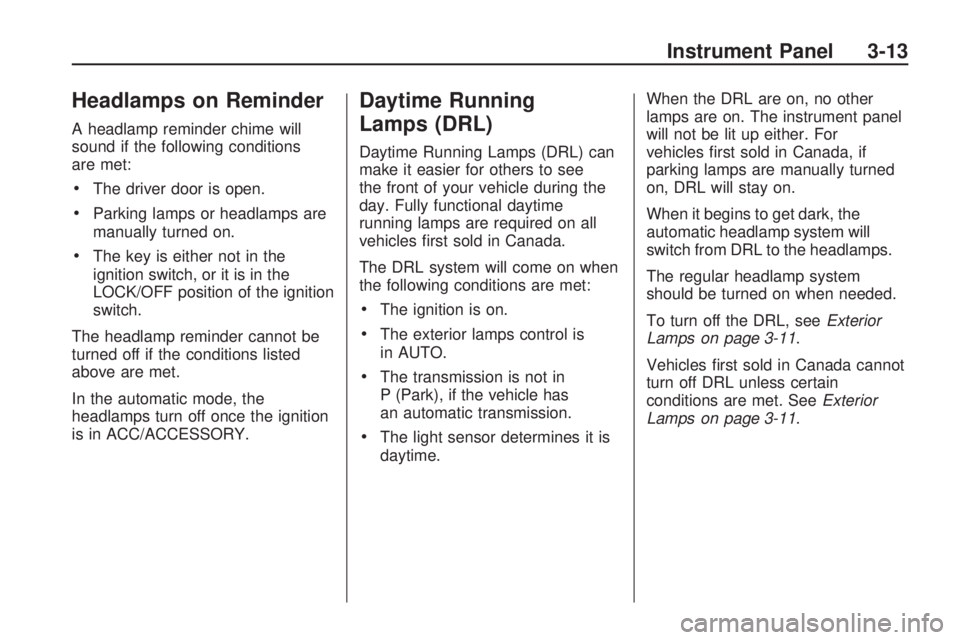
Headlamps on Reminder
A headlamp reminder chime will
sound if the following conditions
are met:
The driver door is open.
Parking lamps or headlamps are
manually turned on.
The key is either not in the
ignition switch, or it is in the
LOCK/OFF position of the ignition
switch.
The headlamp reminder cannot be
turned off if the conditions listed
above are met.
In the automatic mode, the
headlamps turn off once the ignition
is in ACC/ACCESSORY.
Daytime Running
Lamps (DRL)
Daytime Running Lamps (DRL) can
make it easier for others to see
the front of your vehicle during the
day. Fully functional daytime
running lamps are required on all
vehicles �rst sold in Canada.
The DRL system will come on when
the following conditions are met:
The ignition is on.
The exterior lamps control is
in AUTO.
The transmission is not in
P (Park), if the vehicle has
an automatic transmission.
The light sensor determines it is
daytime.When the DRL are on, no other
lamps are on. The instrument panel
will not be lit up either. For
vehicles �rst sold in Canada, if
parking lamps are manually turned
on, DRL will stay on.
When it begins to get dark, the
automatic headlamp system will
switch from DRL to the headlamps.
The regular headlamp system
should be turned on when needed.
To turn off the DRL, seeExterior
Lamps on page 3-11.
Vehicles �rst sold in Canada cannot
turn off DRL unless certain
conditions are met. SeeExterior
Lamps on page 3-11.
Instrument Panel 3-13
Page 132 of 382
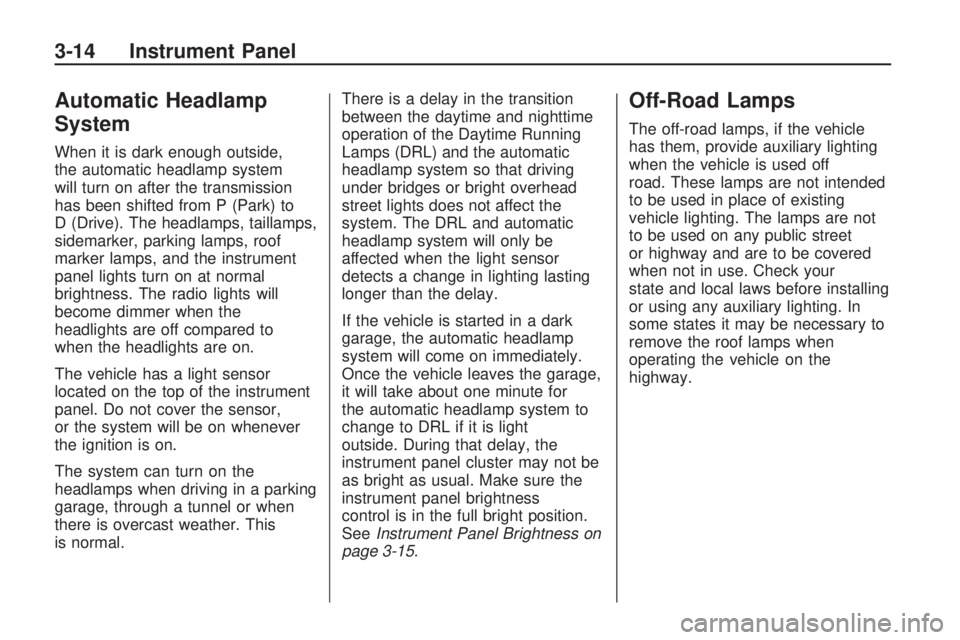
Automatic Headlamp
System
When it is dark enough outside,
the automatic headlamp system
will turn on after the transmission
has been shifted from P (Park) to
D (Drive). The headlamps, taillamps,
sidemarker, parking lamps, roof
marker lamps, and the instrument
panel lights turn on at normal
brightness. The radio lights will
become dimmer when the
headlights are off compared to
when the headlights are on.
The vehicle has a light sensor
located on the top of the instrument
panel. Do not cover the sensor,
or the system will be on whenever
the ignition is on.
The system can turn on the
headlamps when driving in a parking
garage, through a tunnel or when
there is overcast weather. This
is normal.There is a delay in the transition
between the daytime and nighttime
operation of the Daytime Running
Lamps (DRL) and the automatic
headlamp system so that driving
under bridges or bright overhead
street lights does not affect the
system. The DRL and automatic
headlamp system will only be
affected when the light sensor
detects a change in lighting lasting
longer than the delay.
If the vehicle is started in a dark
garage, the automatic headlamp
system will come on immediately.
Once the vehicle leaves the garage,
it will take about one minute for
the automatic headlamp system to
change to DRL if it is light
outside. During that delay, the
instrument panel cluster may not be
as bright as usual. Make sure the
instrument panel brightness
control is in the full bright position.
SeeInstrument Panel Brightness on
page 3-15.
Off-Road Lamps
The off-road lamps, if the vehicle
has them, provide auxiliary lighting
when the vehicle is used off
road. These lamps are not intended
to be used in place of existing
vehicle lighting. The lamps are not
to be used on any public street
or highway and are to be covered
when not in use. Check your
state and local laws before installing
or using any auxiliary lighting. In
some states it may be necessary to
remove the roof lamps when
operating the vehicle on the
highway.
3-14 Instrument Panel
Page 133 of 382
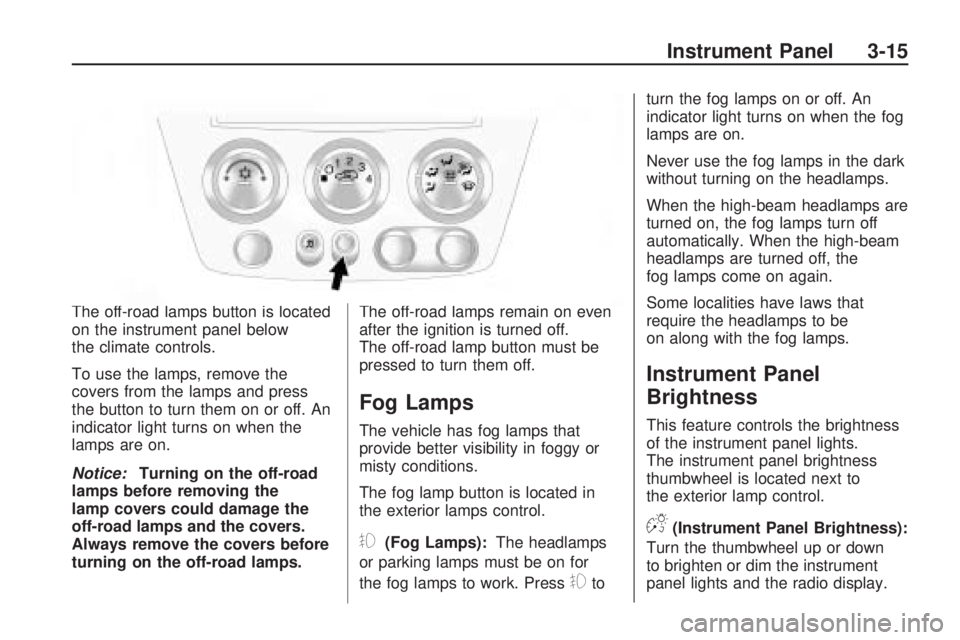
The off-road lamps button is located
on the instrument panel below
the climate controls.
To use the lamps, remove the
covers from the lamps and press
the button to turn them on or off. An
indicator light turns on when the
lamps are on.
Notice:Turning on the off-road
lamps before removing the
lamp covers could damage the
off-road lamps and the covers.
Always remove the covers before
turning on the off-road lamps. The off-road lamps remain on even
after the ignition is turned off.
The off-road lamp button must be
pressed to turn them off.
Fog Lamps
The vehicle has fog lamps that
provide better visibility in foggy or
misty conditions.
The fog lamp button is located in
the exterior lamps control.
#(Fog Lamps):
The headlamps
or parking lamps must be on for
the fog lamps to work. Press
#to turn the fog lamps on or off. An
indicator light turns on when the fog
lamps are on.
Never use the fog lamps in the dark
without turning on the headlamps.
When the high-beam headlamps are
turned on, the fog lamps turn off
automatically. When the high-beam
headlamps are turned off, the
fog lamps come on again.
Some localities have laws that
require the headlamps to be
on along with the fog lamps.
Instrument Panel
Brightness
This feature controls the brightness
of the instrument panel lights.
The instrument panel brightness
thumbwheel is located next to
the exterior lamp control.
D(Instrument Panel Brightness):
Turn the thumbwheel up or down
to brighten or dim the instrument
panel lights and the radio display.
Instrument Panel 3-15
Page 134 of 382
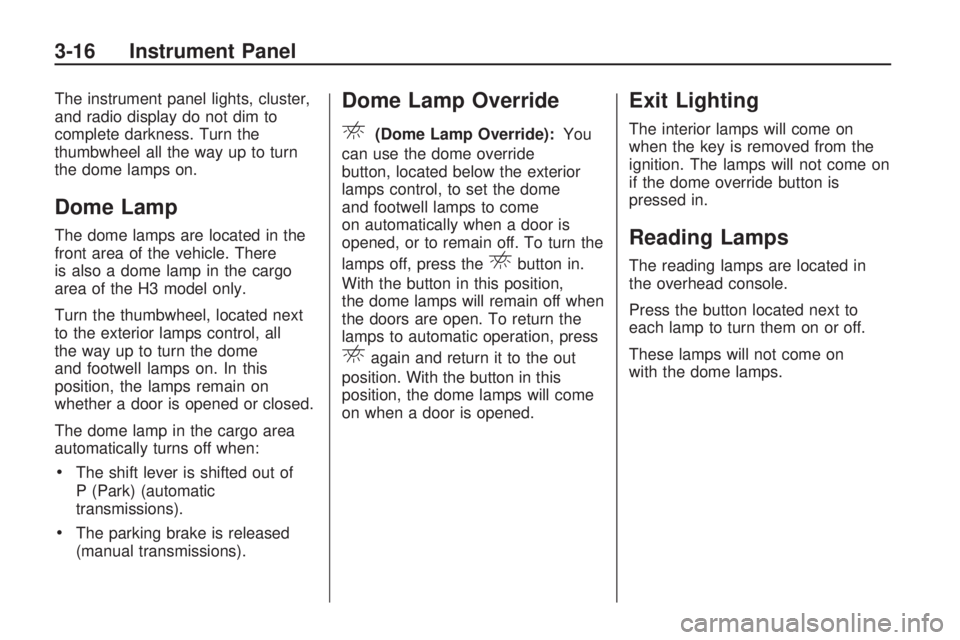
The instrument panel lights, cluster,
and radio display do not dim to
complete darkness. Turn the
thumbwheel all the way up to turn
the dome lamps on.
Dome Lamp
The dome lamps are located in the
front area of the vehicle. There
is also a dome lamp in the cargo
area of the H3 model only.
Turn the thumbwheel, located next
to the exterior lamps control, all
the way up to turn the dome
and footwell lamps on. In this
position, the lamps remain on
whether a door is opened or closed.
The dome lamp in the cargo area
automatically turns off when:
The shift lever is shifted out of
P (Park) (automatic
transmissions).
The parking brake is released
(manual transmissions).
Dome Lamp Override
E
(Dome Lamp Override):You
can use the dome override
button, located below the exterior
lamps control, to set the dome
and footwell lamps to come
on automatically when a door is
opened, or to remain off. To turn the
lamps off, press the
Ebutton in.
With the button in this position,
the dome lamps will remain off when
the doors are open. To return the
lamps to automatic operation, press
Eagain and return it to the out
position. With the button in this
position, the dome lamps will come
on when a door is opened.
Exit Lighting
The interior lamps will come on
when the key is removed from the
ignition. The lamps will not come on
if the dome override button is
pressed in.
Reading Lamps
The reading lamps are located in
the overhead console.
Press the button located next to
each lamp to turn them on or off.
These lamps will not come on
with the dome lamps.
3-16 Instrument Panel
Page 135 of 382
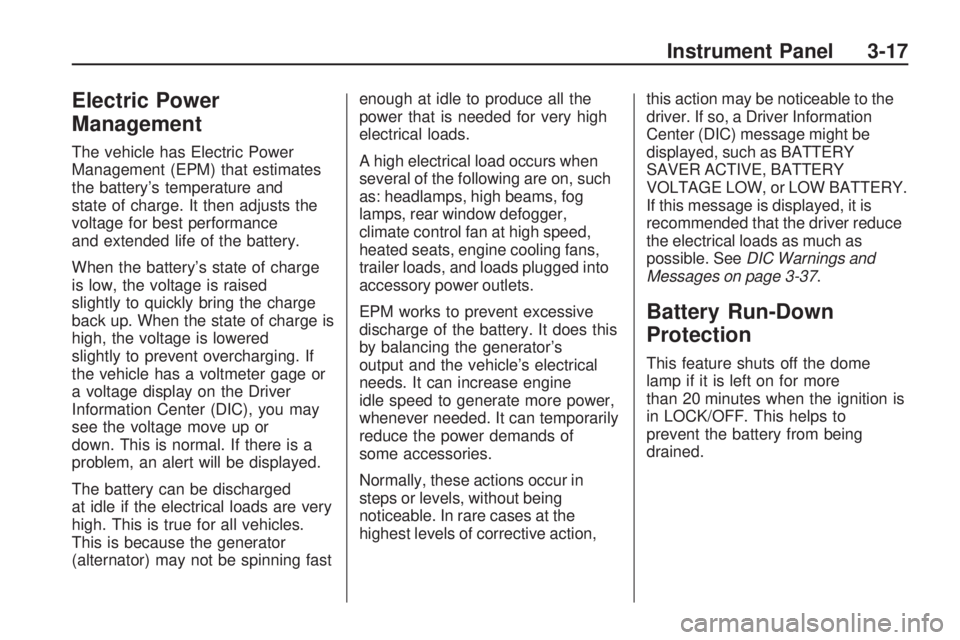
Electric Power
Management
The vehicle has Electric Power
Management (EPM) that estimates
the battery’s temperature and
state of charge. It then adjusts the
voltage for best performance
and extended life of the battery.
When the battery’s state of charge
is low, the voltage is raised
slightly to quickly bring the charge
back up. When the state of charge is
high, the voltage is lowered
slightly to prevent overcharging. If
the vehicle has a voltmeter gage or
a voltage display on the Driver
Information Center (DIC), you may
see the voltage move up or
down. This is normal. If there is a
problem, an alert will be displayed.
The battery can be discharged
at idle if the electrical loads are very
high. This is true for all vehicles.
This is because the generator
(alternator) may not be spinning fastenough at idle to produce all the
power that is needed for very high
electrical loads.
A high electrical load occurs when
several of the following are on, such
as: headlamps, high beams, fog
lamps, rear window defogger,
climate control fan at high speed,
heated seats, engine cooling fans,
trailer loads, and loads plugged into
accessory power outlets.
EPM works to prevent excessive
discharge of the battery. It does this
by balancing the generator’s
output and the vehicle’s electrical
needs. It can increase engine
idle speed to generate more power,
whenever needed. It can temporarily
reduce the power demands of
some accessories.
Normally, these actions occur in
steps or levels, without being
noticeable. In rare cases at the
highest levels of corrective action,this action may be noticeable to the
driver. If so, a Driver Information
Center (DIC) message might be
displayed, such as BATTERY
SAVER ACTIVE, BATTERY
VOLTAGE LOW, or LOW BATTERY.
If this message is displayed, it is
recommended that the driver reduce
the electrical loads as much as
possible. SeeDIC Warnings and
Messages on page 3-37.
Battery Run-Down
Protection
This feature shuts off the dome
lamp if it is left on for more
than 20 minutes when the ignition is
in LOCK/OFF. This helps to
prevent the battery from being
drained.
Instrument Panel 3-17
Page 136 of 382
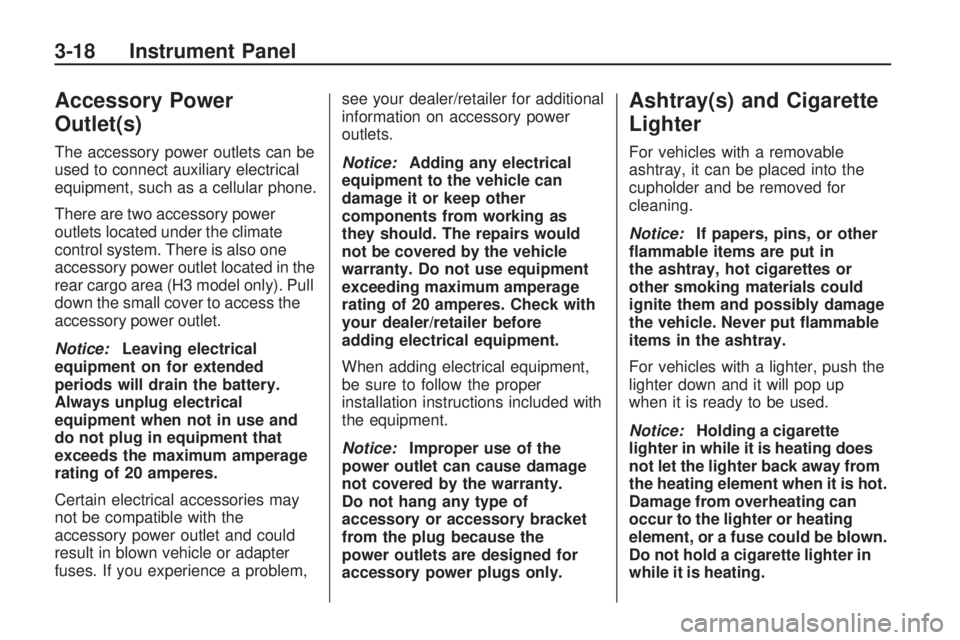
Accessory Power
Outlet(s)
The accessory power outlets can be
used to connect auxiliary electrical
equipment, such as a cellular phone.
There are two accessory power
outlets located under the climate
control system. There is also one
accessory power outlet located in the
rear cargo area (H3 model only). Pull
down the small cover to access the
accessory power outlet.
Notice:Leaving electrical
equipment on for extended
periods will drain the battery.
Always unplug electrical
equipment when not in use and
do not plug in equipment that
exceeds the maximum amperage
rating of 20 amperes.
Certain electrical accessories may
not be compatible with the
accessory power outlet and could
result in blown vehicle or adapter
fuses. If you experience a problem,see your dealer/retailer for additional
information on accessory power
outlets.
Notice:Adding any electrical
equipment to the vehicle can
damage it or keep other
components from working as
they should. The repairs would
not be covered by the vehicle
warranty. Do not use equipment
exceeding maximum amperage
rating of 20 amperes. Check with
your dealer/retailer before
adding electrical equipment.
When adding electrical equipment,
be sure to follow the proper
installation instructions included with
the equipment.
Notice:Improper use of the
power outlet can cause damage
not covered by the warranty.
Do not hang any type of
accessory or accessory bracket
from the plug because the
power outlets are designed for
accessory power plugs only.
Ashtray(s) and Cigarette
Lighter
For vehicles with a removable
ashtray, it can be placed into the
cupholder and be removed for
cleaning.
Notice:If papers, pins, or other
�ammable items are put in
the ashtray, hot cigarettes or
other smoking materials could
ignite them and possibly damage
the vehicle. Never put �ammable
items in the ashtray.
For vehicles with a lighter, push the
lighter down and it will pop up
when it is ready to be used.
Notice:Holding a cigarette
lighter in while it is heating does
not let the lighter back away from
the heating element when it is hot.
Damage from overheating can
occur to the lighter or heating
element, or a fuse could be blown.
Do not hold a cigarette lighter in
while it is heating.
3-18 Instrument Panel
Page 137 of 382
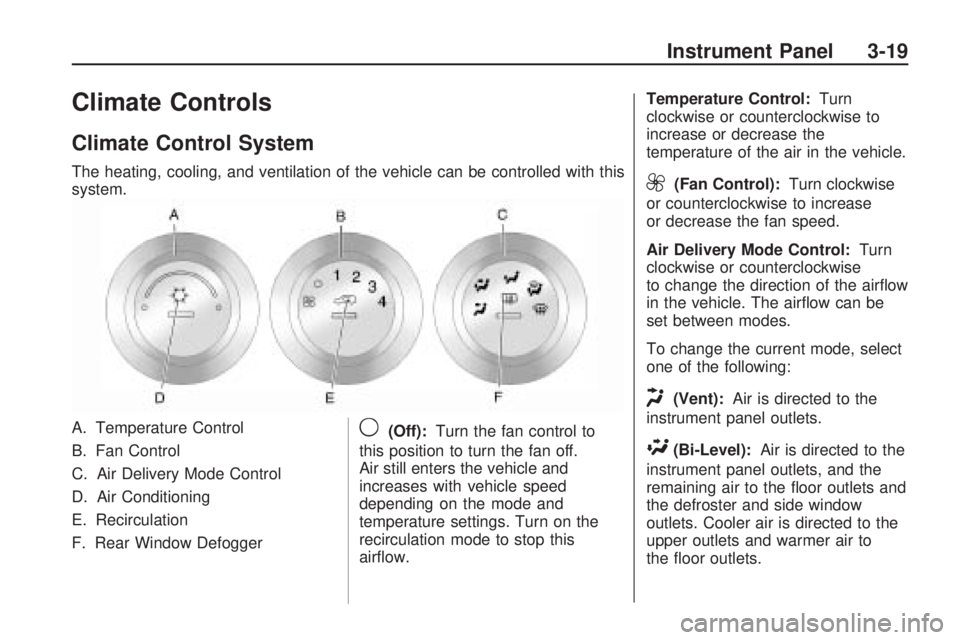
Climate Controls
Climate Control System
The heating, cooling, and ventilation of the vehicle can be controlled with this
system.
A. Temperature Control
B. Fan Control
C. Air Delivery Mode Control
D. Air Conditioning
E. Recirculation
F. Rear Window Defogger
9(Off):Turn the fan control to
this position to turn the fan off.
Air still enters the vehicle and
increases with vehicle speed
depending on the mode and
temperature settings. Turn on the
recirculation mode to stop this
air�ow. Temperature Control:
Turn
clockwise or counterclockwise to
increase or decrease the
temperature of the air in the vehicle.
9(Fan Control): Turn clockwise
or counterclockwise to increase
or decrease the fan speed.
Air Delivery Mode Control: Turn
clockwise or counterclockwise
to change the direction of the air�ow
in the vehicle. The air�ow can be
set between modes.
To change the current mode, select
one of the following:
H(Vent): Air is directed to the
instrument panel outlets.
\(Bi-Level): Air is directed to the
instrument panel outlets, and the
remaining air to the �oor outlets and
the defroster and side window
outlets. Cooler air is directed to the
upper outlets and warmer air to
the �oor outlets.
Instrument Panel 3-19
Page 138 of 382
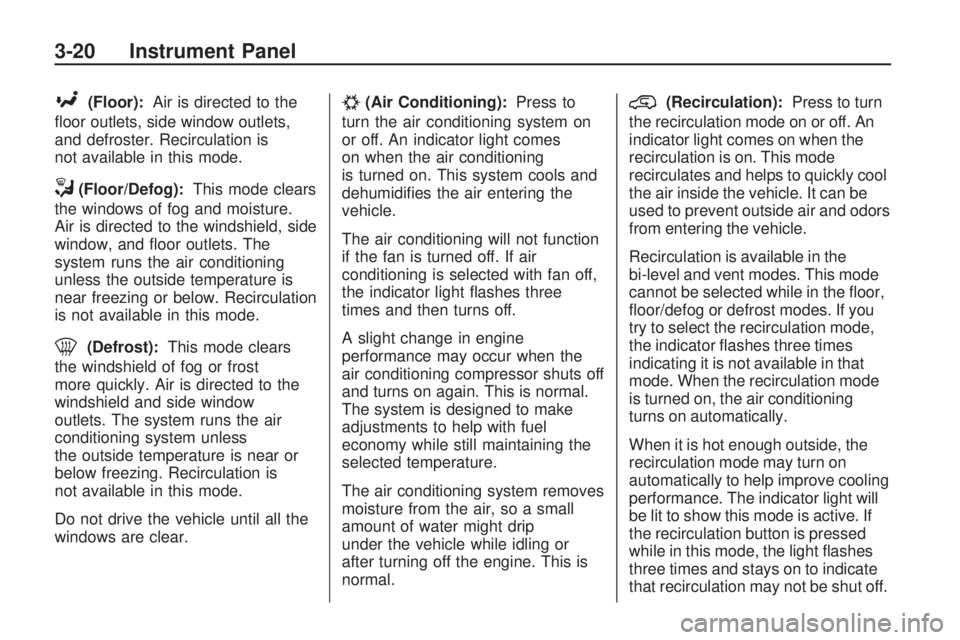
[(Floor):Air is directed to the
�oor outlets, side window outlets,
and defroster. Recirculation is
not available in this mode.
/(Floor/Defog):This mode clears
the windows of fog and moisture.
Air is directed to the windshield, side
window, and �oor outlets. The
system runs the air conditioning
unless the outside temperature is
near freezing or below. Recirculation
is not available in this mode.
0(Defrost):This mode clears
the windshield of fog or frost
more quickly. Air is directed to the
windshield and side window
outlets. The system runs the air
conditioning system unless
the outside temperature is near or
below freezing. Recirculation is
not available in this mode.
Do not drive the vehicle until all the
windows are clear.
#(Air Conditioning):Press to
turn the air conditioning system on
or off. An indicator light comes
on when the air conditioning
is turned on. This system cools and
dehumidi�es the air entering the
vehicle.
The air conditioning will not function
if the fan is turned off. If air
conditioning is selected with fan off,
the indicator light �ashes three
times and then turns off.
A slight change in engine
performance may occur when the
air conditioning compressor shuts off
and turns on again. This is normal.
The system is designed to make
adjustments to help with fuel
economy while still maintaining the
selected temperature.
The air conditioning system removes
moisture from the air, so a small
amount of water might drip
under the vehicle while idling or
after turning off the engine. This is
normal.@(Recirculation):Press to turn
the recirculation mode on or off. An
indicator light comes on when the
recirculation is on. This mode
recirculates and helps to quickly cool
the air inside the vehicle. It can be
used to prevent outside air and odors
from entering the vehicle.
Recirculation is available in the
bi-level and vent modes. This mode
cannot be selected while in the �oor,
�oor/defog or defrost modes. If you
try to select the recirculation mode,
the indicator �ashes three times
indicating it is not available in that
mode. When the recirculation mode
is turned on, the air conditioning
turns on automatically.
When it is hot enough outside, the
recirculation mode may turn on
automatically to help improve cooling
performance. The indicator light will
be lit to show this mode is active. If
the recirculation button is pressed
while in this mode, the light �ashes
three times and stays on to indicate
that recirculation may not be shut off.
3-20 Instrument Panel
Page 139 of 382
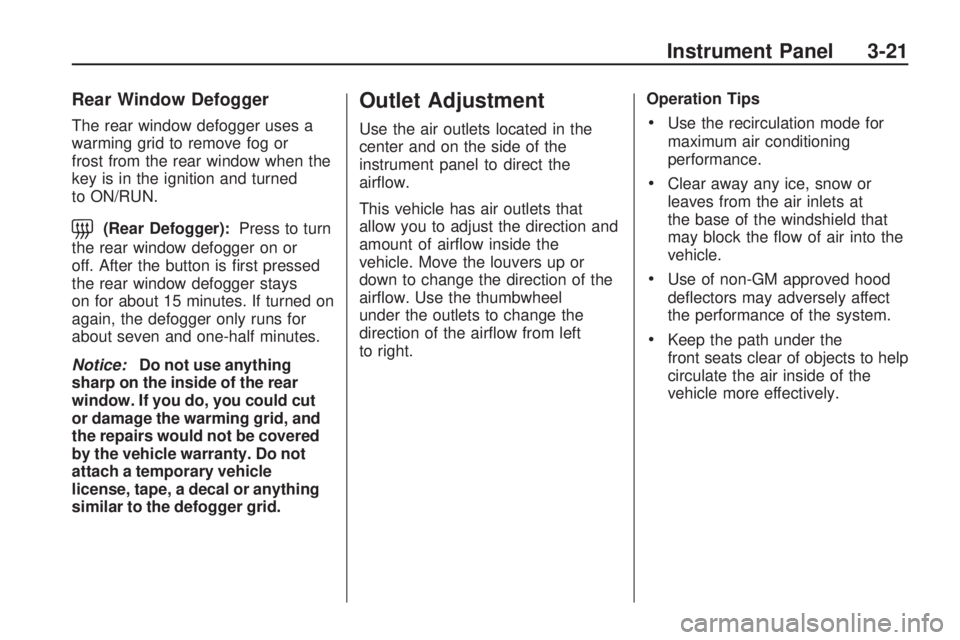
Rear Window Defogger
The rear window defogger uses a
warming grid to remove fog or
frost from the rear window when the
key is in the ignition and turned
to ON/RUN.
=(Rear Defogger):Press to turn
the rear window defogger on or
off. After the button is �rst pressed
the rear window defogger stays
on for about 15 minutes. If turned on
again, the defogger only runs for
about seven and one-half minutes.
Notice:Do not use anything
sharp on the inside of the rear
window. If you do, you could cut
or damage the warming grid, and
the repairs would not be covered
by the vehicle warranty. Do not
attach a temporary vehicle
license, tape, a decal or anything
similar to the defogger grid.
Outlet Adjustment
Use the air outlets located in the
center and on the side of the
instrument panel to direct the
air�ow.
This vehicle has air outlets that
allow you to adjust the direction and
amount of air�ow inside the
vehicle. Move the louvers up or
down to change the direction of the
air�ow. Use the thumbwheel
under the outlets to change the
direction of the air�ow from left
to right.Operation TipsUse the recirculation mode for
maximum air conditioning
performance.
Clear away any ice, snow or
leaves from the air inlets at
the base of the windshield that
may block the �ow of air into the
vehicle.
Use of non-GM approved hood
de�ectors may adversely affect
the performance of the system.
Keep the path under the
front seats clear of objects to help
circulate the air inside of the
vehicle more effectively.
Instrument Panel 3-21
Page 140 of 382
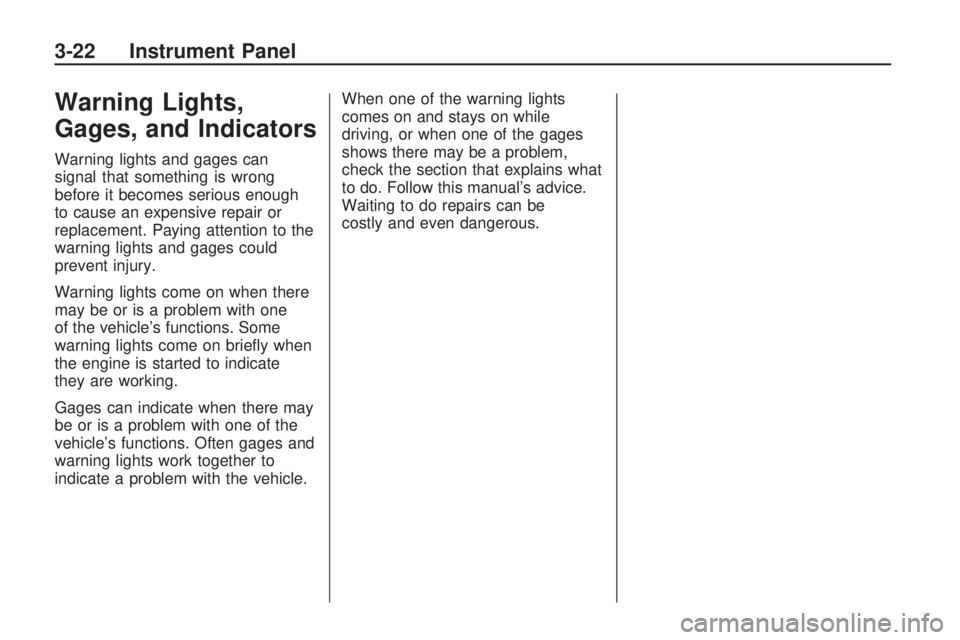
Warning Lights,
Gages, and Indicators
Warning lights and gages can
signal that something is wrong
before it becomes serious enough
to cause an expensive repair or
replacement. Paying attention to the
warning lights and gages could
prevent injury.
Warning lights come on when there
may be or is a problem with one
of the vehicle’s functions. Some
warning lights come on brie�y when
the engine is started to indicate
they are working.
Gages can indicate when there may
be or is a problem with one of the
vehicle’s functions. Often gages and
warning lights work together to
indicate a problem with the vehicle.When one of the warning lights
comes on and stays on while
driving, or when one of the gages
shows there may be a problem,
check the section that explains what
to do. Follow this manual’s advice.
Waiting to do repairs can be
costly and even dangerous.
3-22 Instrument Panel